The Trade-Off Between Sanitizer Resistance and Virulence Genes: Genomic Insights into E. coli Adaptation
Abstract
1. Introduction
2. Results and Discussion
2.1. Determination of Serotype, Antimicrobial Resistance, and Presence of stx and Biofilm Genes
2.2. Correlation Between Target Genes and Multiple Correspondence Analysis
2.3. Large-Scale Genomic Association Between Presence of qac with stx1, stx2, or Both stx Genes from NCBI Pathogen Detection Database
2.4. Analysis of Phage Insertion and Genome Synteny
3. Materials and Methods
3.1. Strain Selection and DNA Extraction and Sequencing
3.2. Characterization of Serogroups, Virulence Genes, and Antimicrobial Resistance and Phylogenetic Analysis
3.3. Comparison of Presence of qac with stx1, stx2, or stx1 and stx2 Using the NCBI Pathogen Detection Database
3.4. Statistical Analysis of Data
4. Conclusions
Author Contributions
Funding
Institutional Review Board Statement
Informed Consent Statement
Data Availability Statement
Conflicts of Interest
References
- Lebelo, K.; Malebo, N.; Mochane, M.J.; Masinde, M. Chemical contamination pathways and the food safety implications along the various stages of food production: A review. Int. J. Environ. Res. Public Health 2021, 18, 5795. [Google Scholar] [CrossRef] [PubMed]
- de Assis, D.C.S.; da Silva, T.M.L.; Brito, R.F.; da Silva, L.C.G.; Lima, W.G.; Brito, J.C.M. Shiga toxin-producing Escherichia coli (STEC) in bovine meat and meat products over the last 15 years in Brazil: A systematic review and meta-analysis. Meat Sci. 2021, 173, 108394. [Google Scholar] [CrossRef] [PubMed]
- Castro, V.S.; Carvalho, R.C.T.; Conte-Junior, C.A.; Figuiredo, E.E.S. Shiga-toxin producing Escherichia coli: Pathogenicity, supershedding, diagnostic methods, occurrence, and foodborne outbreaks. Compr. Rev. Food Sci. Food Saf. 2017, 16, 1269–1280. [Google Scholar] [CrossRef] [PubMed]
- Luna-Gierke, R.E.; Griffin, P.M.; Gould, L.H.; Herman, K.; Bopp, C.A.; Strockbine, N.; Mody, R.K. Outbreaks of non-O157 Shiga toxin-producing Escherichia coli infection: USA. Epidemiol. Infect. 2014, 142, 2270–2280. [Google Scholar] [CrossRef]
- Ludwig, J.B.; Shi, X.; Shridhar, P.B.; Roberts, E.L.; DebRoy, C.; Phebus, R.K.; Bai, J.; Nagaraja, T.G. Multiplex PCR assays for the detection of one hundred and thirty-seven serogroups of shiga toxin-producing Escherichia coli associated with cattle. Front. Cell. Infect. Microbiol. 2020, 10, 378. [Google Scholar] [CrossRef]
- Elmonir, W.; Shalaan, S.; Tahoun, A.; Mahmoud, S.F.; Remela, E.M.A.; Eissa, R.; El-Sharkawy, H.; Shukry, M.; Zahran, R.N. Prevalence, antimicrobial resistance, and genotyping of Shiga toxin-producing Escherichia coli in foods of cattle origin, diarrheic cattle, and diarrheic humans in Egypt. Gut Pathog. 2021, 13, 8. [Google Scholar] [CrossRef]
- Tarr, P.I.; Freedman, S.B. Why antibiotics should not be used to treat Shiga toxin-producing Escherichia coli infections. Curr. Opin. Gastroenterol. 2022, 38, 30–38. [Google Scholar] [CrossRef]
- Fraser, A.M.; Anderson, J.; Goncalves, J.; Black, E.; Starobin, A.; Buckley, D.; Grinstead, D.; Manuel, C.; Hollingsworth, J. Sanitizers and Disinfectants: A Retail Food and Foodservice Perspective. Food Prot. Trends 2021, 41, 358–367. [Google Scholar] [CrossRef]
- Sundheim, G.; Langsrud, S.; Heir, E.; Holck, A.L. Bacterial resistance to disinfectants containing quaternary ammonium compounds. Int. Biodeterior. Biodegrad. 1998, 41, 235–239. [Google Scholar] [CrossRef]
- Boyce, J.M. Quaternary ammonium disinfectants and antiseptics: Tolerance, resistance and potential impact on antibiotic resistance. Antimicrob. Resist. Infect. Control 2023, 12, 32. [Google Scholar] [CrossRef]
- Buffet-Bataillon, S.; Tattevin, P.; Bonnaure-Mallet, M.; Jolivet-Gougeon, A. Emergence of resistance to antibacterial agents: The role of quaternary ammonium compounds—A critical review. Int. J. Antimicrob. Agents 2012, 39, 381–389. [Google Scholar] [CrossRef] [PubMed]
- Castro, V.S.; Mutz, Y.d.S.; Rosario, D.K.A.; Cunha-Neto, A.; Figueiredo, E.E.d.S.; Conte-Junior, C.A. Inactivation of multi-drug resistant non-typhoidal Salmonella and wild-type Escherichia coli STEC using organic acids: A potential alternative to the food industry. Pathogens 2020, 9, 849. [Google Scholar] [CrossRef] [PubMed]
- Kumar, G.D.; Krishnaprabha; Oguadinma, I.C.; Mishra, A.; Suh, J.H.; Singh, M. Influence of antibiotic-resistance and exudate on peroxyacetic acid tolerance in O157 and non-O157 Shiga toxin producing E. coli. Int. J. Food Microbiol. 2023, 391–393, 110144. [Google Scholar] [CrossRef]
- Ovchinnikov, V.; Stone, T.A.; Deber, C.M.; Kaplus, M. Structure of the EmrE multidrug resistance efflux transporter and its use for inhibitor peptide design. Proc. Natl. Acad. Sci. USA 2018, 115, E7932–E7941. [Google Scholar] [CrossRef] [PubMed]
- Zhou, F.; Wang, D.; Hu, J.; Zhang, Y.; Tan, B.K.; Lin, S. Control Measurements of Escherichia coli Biofilm: A Review. Foods 2022, 11, 2469. [Google Scholar] [CrossRef]
- Cadena, M.; Kelman, T.; Marco, M.L.; Pitesky, M. Understanding Antimicrobial Resistance (AMR) profiles of Salmonella biofilm and planktonic bacteria challenged with disinfectants commonly used during poultry processing. Foods 2019, 8, 275. [Google Scholar] [CrossRef]
- Wicaksono, W.A.; Erschen, S.; Krause, R.; Müller, H.; Cernava, T.; Berg, G. Enhanced survival of multi-species biofilms under stress is promoted by low-abundant but antimicrobial-resistant keystone species. J. Hazard. Mater. 2022, 422, 126836. [Google Scholar] [CrossRef]
- Zhang, P.; Yang, X. Genetic Characteristics of the transmissible locus of stress tolerance (tLST) and tLST harboring Escherichia coli as revealed by large-scale genomic analysis. Appl. Environ. Microbiol. 2022, 88, e0218521. [Google Scholar] [CrossRef]
- Shin, H.-H.; Cho, S.-H. Prevalence of Antimicrobial Resistance in Escherichia coli Strains Isolated from Fishery Workers. Osong Public Health Res. Perspect. 2013, 4, 72–75. [Google Scholar] [CrossRef][Green Version]
- Saini, P.; Bandsode, V.; Singh, A.; Mendem, S.K.; Semmler, T.; Alam, M.; Ahmed, N. Genomic insights into virulence, antimicrobial resistance, and adaptation acumen of Escherichia coli isolated from an urban environment. mBio 2024, 15, e0354523. [Google Scholar] [CrossRef]
- Nji, E.; Kazibwe, J.; Hambridge, T.; Joko, C.A.; Larbi, A.A.; Damptey, L.A.O.; Nkansa-Gyamfi, N.A.; Lundborg, C.S.; Lien, L.T.Q. High prevalence of antibiotic resistance in commensal Escherichia coli from healthy human sources in community settings. Sci. Rep. 2021, 11, 3372. [Google Scholar] [CrossRef]
- Massella, E.; Giacometti, F.; Bonilauri, P.; Reid, C.J.; Djordjevic, S.P.; Merialdi, G.; Bacci, C.; Fiorentini, L.; Massi, P.; Bardasi, L.; et al. Antimicrobial Resistance Profile and ExPEC Virulence Potential in Commensal Escherichia coli of Multiple Sources. Antibiotics 2021, 10, 351. [Google Scholar] [CrossRef] [PubMed]
- Castro, V.S.; Fang, Y.; Yang, X.; Stanford, K. Association of resistance to quaternary ammonium compounds and organic acids with genetic markers and their relationship to Escherichia coli serogroup. Food Microbiol. 2023, 113, 104267. [Google Scholar] [CrossRef] [PubMed]
- Castro, V.S.; Polo, R.O.; Figueiredo, E.E.d.S.; Bumunange, E.W.; McAllister, T.; King, R.; Conte-Junior, C.A.; Stanford, K. Inconsistent PCR detection of Shiga toxin-producing Escherichia coli: Insights from whole genome sequence analyses. PLoS ONE 2021, 16, e0257168. [Google Scholar] [CrossRef] [PubMed]
- Uelze, L.; Grützke, J.; Borowiak, M.; Hammerl, J.A.; Juraschek, K.; Deneke, C.; Tausch, S.H.; Malorny, B. Typing methods based on whole genome sequencing data. One Health Outlook 2020, 2, 3. [Google Scholar] [CrossRef]
- Joris, M.-A.; Verstraete, K.; De Reu, K.; De Zutter, L. Loss of vtx genes after the first subcultivation step of verocytotoxigenic Escherichia coli O157 and Non-O157 during isolation from naturally contaminated fecal samples. Toxins 2011, 3, 672–677. [Google Scholar] [CrossRef]
- Senthakumaran, T.; Brandal, L.T.; Lindstedt, B.-A.; Jørgensen, S.B.; Charnock, C.; Tunsjø, H.S. Implications of stx loss for clinical diagnostics of Shiga toxin-producing Escherichia coli. Eur. J. Clin. Microbiol. Infect. Dis. 2018, 37, 2361–2370. [Google Scholar] [CrossRef]
- Puangseree, J.; Jeamsripong, S.; Prathan, R.; Pungpian, C.; Chuanchuen, R. Resistance to widely-used disinfectants and heavy metals and cross resistance to antibiotics in Escherichia coli isolated from pigs, pork and pig carcass. Food Control 2021, 124, 107892. [Google Scholar] [CrossRef]
- Kampf, G.; Kampf, G. Antiseptic Stewardship for Surface Disinfectants. In Antiseptic Stewardship: Biocide Resistance and Clinical Implications; Springer International Publishing: Cham, Switzerland, 2018; pp. 661–669. [Google Scholar]
- Li, Y.; Ge, X. Role of Berberine as a potential efflux pump inhibitor against MdfA from Escherichia coli: In Vitro and In Silico studies. Microbiol. Spectr. 2023, 11, e0332422. [Google Scholar] [CrossRef]
- Edgar, R.; Bibi, E. MdfA, an Escherichia coli multidrug resistance protein with an extraordinarily broad spectrum of drug recognition. J. Bacteriol. 1997, 179, 2274–2280. [Google Scholar] [CrossRef]
- Liu, Y.; Hatim, T.; Chunyan, W.; Zhonggao, X.; Min, D. Diagnosis and treatment for Shiga toxin-producing Escherichia coli associated hemolytic uremic syndrome. Toxins. 2022, 15, 10. [Google Scholar] [CrossRef] [PubMed]
- Dong, H.-J.; Lee, S.; Kim, W.; An, J.-U.; Kim, J.; Kim, D.; Cho, S. Prevalence, virulence potential, and pulsed-field gel electrophoresis profiling of Shiga toxin-producing Escherichia coli strains from cattle. Gut Pathog. 2017, 9, 22. [Google Scholar] [CrossRef] [PubMed]
- Johannes, L.; Römer, W. Shiga toxins—From cell biology to biomedical applications. Nat. Rev. Microbiol. 2010, 8, 105–116. [Google Scholar] [CrossRef]
- Schellhorn, H.E. Function, Evolution, and Composition of the RpoS Regulon in Escherichia coli. Front. Microbiol. 2020, 11, 560099. [Google Scholar] [CrossRef] [PubMed]
- Sapountzis, P.; Segura, A.; Desvaux, M.; Forano, E. An overview of the elusive passenger in the gastrointestinal tract of cattle: The shiga toxin producing Escherichia coli. Microorganisms 2020, 8, 877. [Google Scholar] [CrossRef]
- Heller, D.M.; Tavag, M.; Hochschild, A. CbtA toxin of Escherichia coli inhibits cell division and cell elongation via direct and independent interactions with FtsZ and MreB. PLoS Genet. 2017, 13, e1007007. [Google Scholar] [CrossRef]
- Yamaguchi, Y.; Park, J.-H.; Inouye, M. Toxin-Antitoxin Systems in Bacteria and Archaea. Annu. Rev. Genet. 2011, 45, 61–79. [Google Scholar] [CrossRef]
- Tan, Q.; Awano, N.; Inouye, M. YeeV is an Escherichia coli toxin that inhibits cell division by targeting the cytoskeleton proteins, FtsZ and MreB. Mol. Microbiol. 2011, 79, 109–118. [Google Scholar] [CrossRef]
- Mohapatra, S.; Yutao, L.; Goh, S.G.; Ng, C.; Luhua, Y.; Tran, N.H.; Gin, K.Y.H. Quaternary ammonium compounds of emerging concern: Classification, occurrence, fate, toxicity and antimicrobial resistance. J. Hazard. Mater. 2023, 445, p.130393. [Google Scholar] [CrossRef]
- Belousov, M.V.; Kosolapova, A.O.; Fayoud, H.; Sulatsky, M.I.; Sulatskaya, A.I.; Romanenko, M.N.; Bobylev, A.G.; Antonets, K.S.; Nizhnikov, A.A. OmpC and OmpF outer membrane proteins of Escherichia coli and Salmonella enterica form bona fide amyloids. Int. J. Mol. Sci. 2023, 24, 15522. [Google Scholar] [CrossRef]
- Ambrose, S.J.; Hall, R.M. dfrA trimethoprim resistance genes found in Gram-negative bacteria: Compilation and unambiguous numbering. J. Antimicrob. Chemother. 2021, 76, 2748–2756. [Google Scholar] [CrossRef] [PubMed]
- Rebelo, A.; Duarte, B.; Freitas, A.R.; Peixe, L.; Antunes, P.; Novais, C. Exploring Peracetic Acid and Acidic pH Tolerance of Antibiotic-Resistant Non-Typhoidal Salmonella and Enterococcus faecium from Diverse Epidemiological and Genetic Backgrounds. Microorganisms 2023, 11, 2330. [Google Scholar] [CrossRef] [PubMed]
- Krüger, A.; Lucchesi, P.M.A. Shiga toxins and stx phages: Highly diverse entities. Microbiology 2015, 161, 451–462. [Google Scholar] [CrossRef] [PubMed]
- Ghaly, T.M.; Gillings, M.R.; Penesyan, A.; Qi, Q.; Rajabal, V.; Tetu, S.G. The natural history of integrons. Microorganisms 2021, 9, 2212. [Google Scholar] [CrossRef]
- Bhat, B.A.; Mir, R.A.; Qadri, H.; Dhiman, R.; Almilaibary, A.; Alkhanani, M.; Mir, M.A. Integrons in the development of antimicrobial resistance: Critical review and perspectives. Front. Microbiol. 2023, 14, 1231938. [Google Scholar] [CrossRef]
- Bragg, R.; Jansen, A.; Coetzee, M.; van der Westhuizen, W.; Boucher, C. Bacterial resistance to quaternary ammonium compounds (QAC) disinfectants. In Proceedings of the Infectious Diseases and Nanomedicine II: First International Conference (ICIDN–2012), Kathmandu, Nepal, 15–18 December 2012; Springer: New Delhi, India, 2014; pp. 1–13. [Google Scholar]
- Yang, M.; Xia, Q.; Du, S.; Zhang, Z.; Qin, F.; Zhao, Y. Genomic characterization and distribution pattern of a novel marine OM43 phage. Front. Microbiol. 2021, 12, 651326. [Google Scholar] [CrossRef]
- Nautiyal, A.; Thakur, M. Prokaryotic DNA crossroads: Holliday junction formation and resolution. ACS omega 2024, 9, 12515–12538. [Google Scholar] [CrossRef]
- Fonseca, É.L.; Vicente, A.C. Integron functionality and genome innovation: An update on the subtle and smart strategy of integrase and gene cassette expression regulation. Microorganisms 2022, 10, 224. [Google Scholar] [CrossRef]
- Zheng, W.; Huyan, J.; Tian, Z.; Zhang, Y.; Wen, X. Clinical class 1 integron-integrase gene—A promising indicator to monitor the abundance and elimination of antibiotic resistance genes in an urban wastewater treatment plant. Environ. Int. 2020, 135, 105372. [Google Scholar] [CrossRef]
- R Core Team. R: A Language and Environment for Statistical Computing; R Foundation for Statistical Computing: Vienna, Austria, 2023; Available online: https://www.R-project.org/ (accessed on 11 December 2023).
- Di Franco, G. Multiple correspondence analysis: One only or several techniques? Qual. Quant. 2016, 50, 1299–1315. [Google Scholar] [CrossRef]
- Greenacre, Z.A.; Terlemez, L.; Sentürk, S. Usage as Complementary Correspondence Analysis and Logistic Regression in a Scientific Survey on Self-Healing Methods. Open J. Stat. 2014, 04, 912–920. [Google Scholar] [CrossRef][Green Version]
- Lê, S.; Josse, J.; Husson, F. FactoMineR: An R Package for Multivariate Analysis. J. Stat. Softw. 2008, 25, 1–18. [Google Scholar] [CrossRef]
- Kassambara, A.; Mundt, F. Factoextra: Extract and Visualize the Results of Multivariate Data Analyses. CRAN: Contributed Packages, v. 1.0.7. 2016. Available online: https://doi.org/10.32614/cran.package.factoextra (accessed on 25 February 2025).

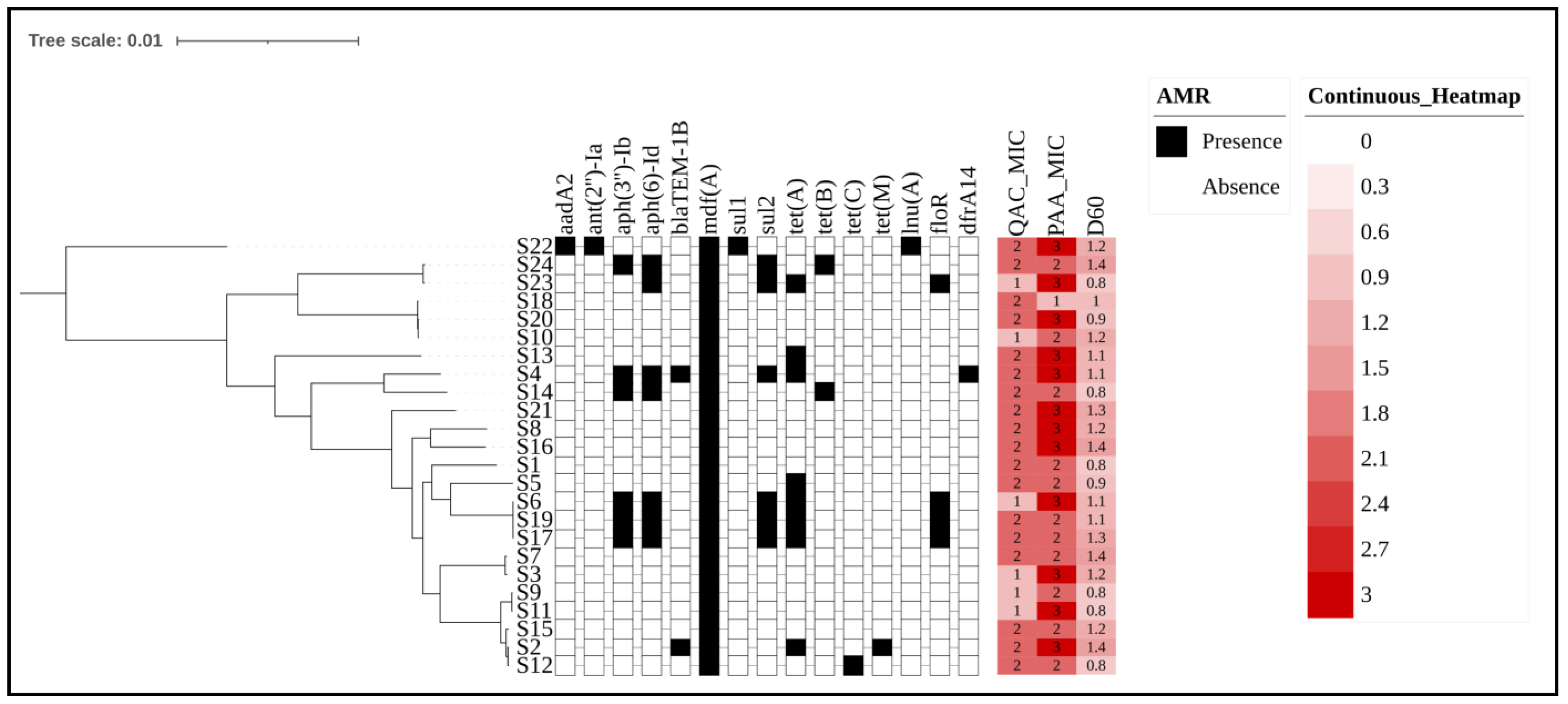
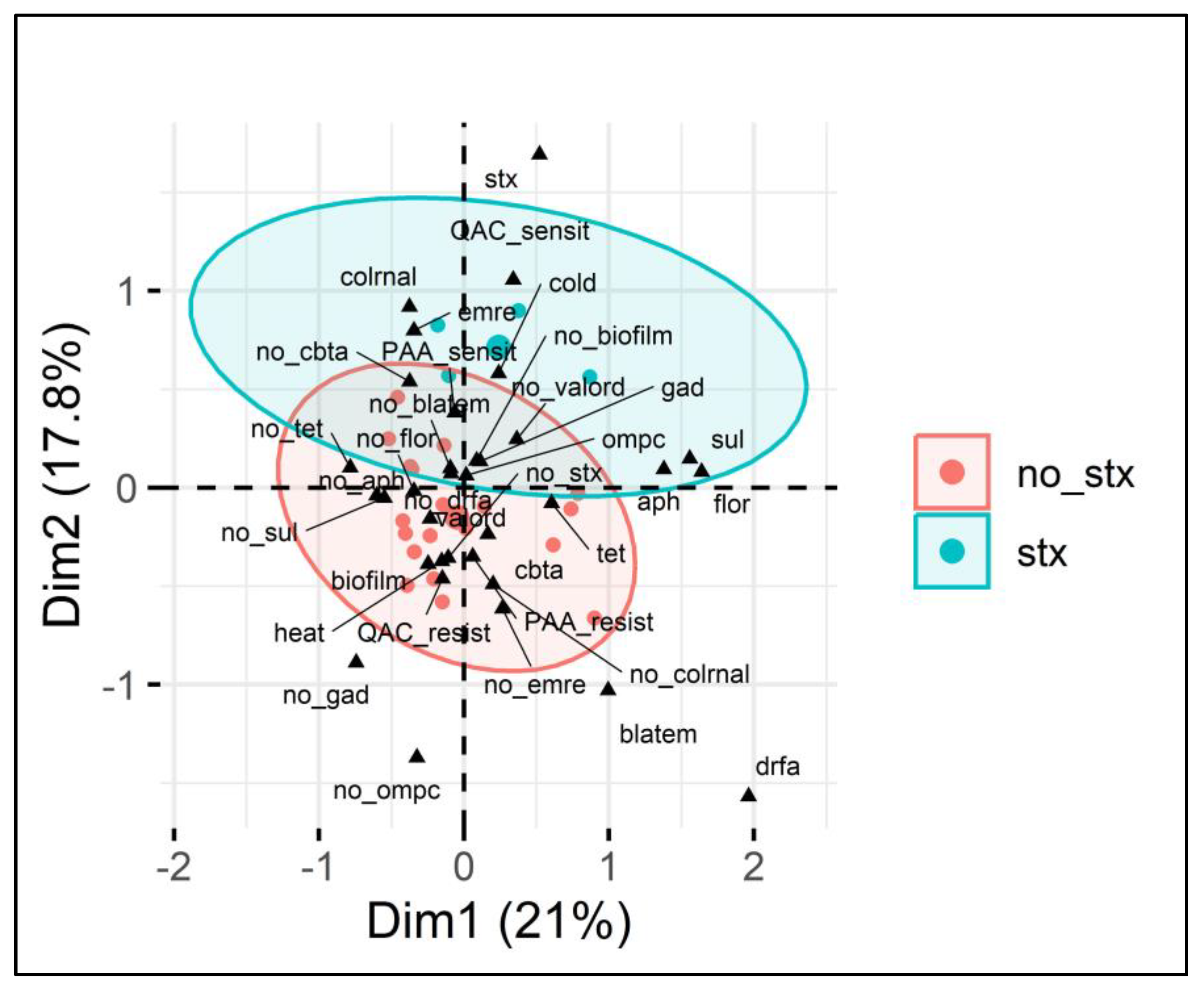
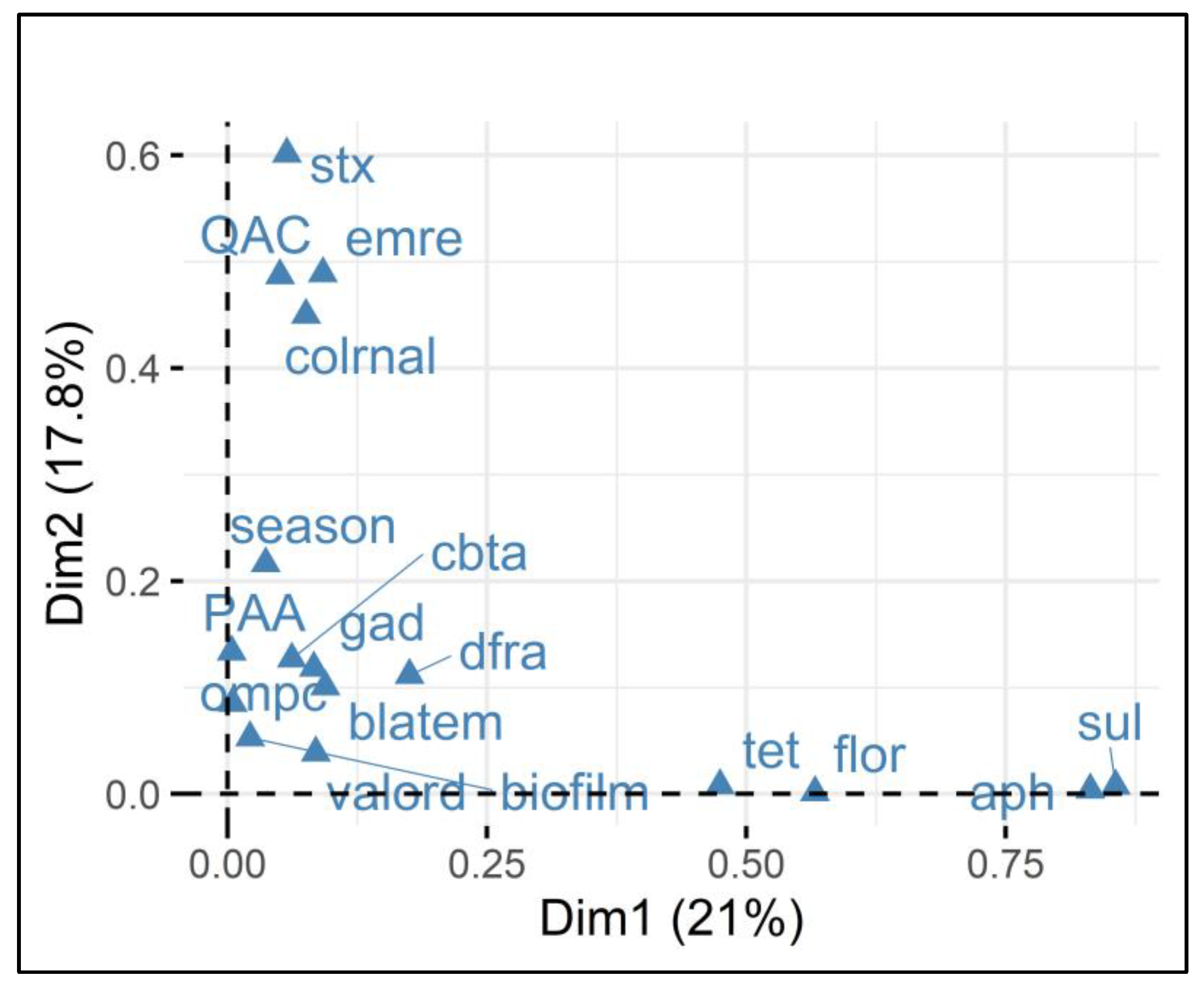
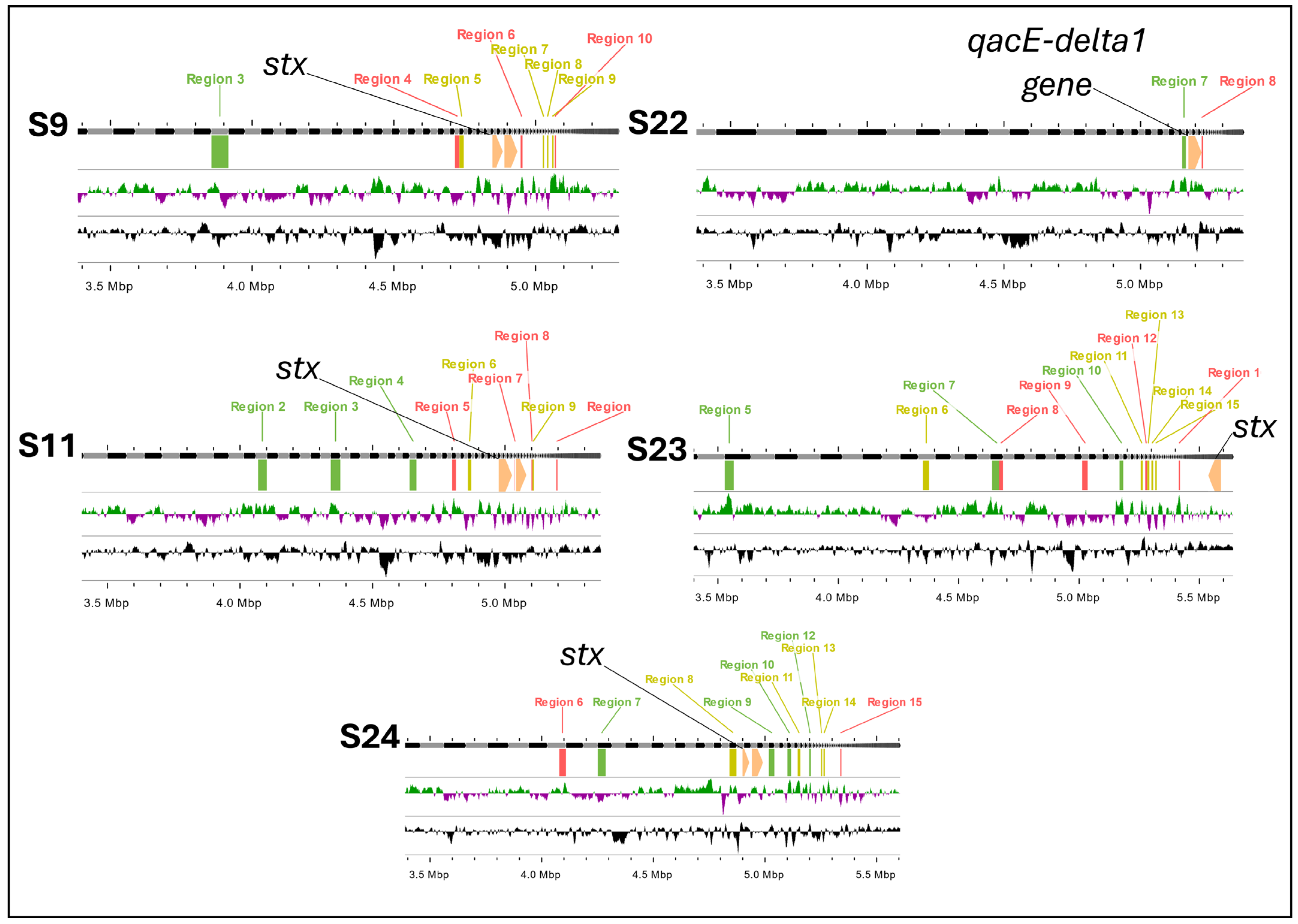
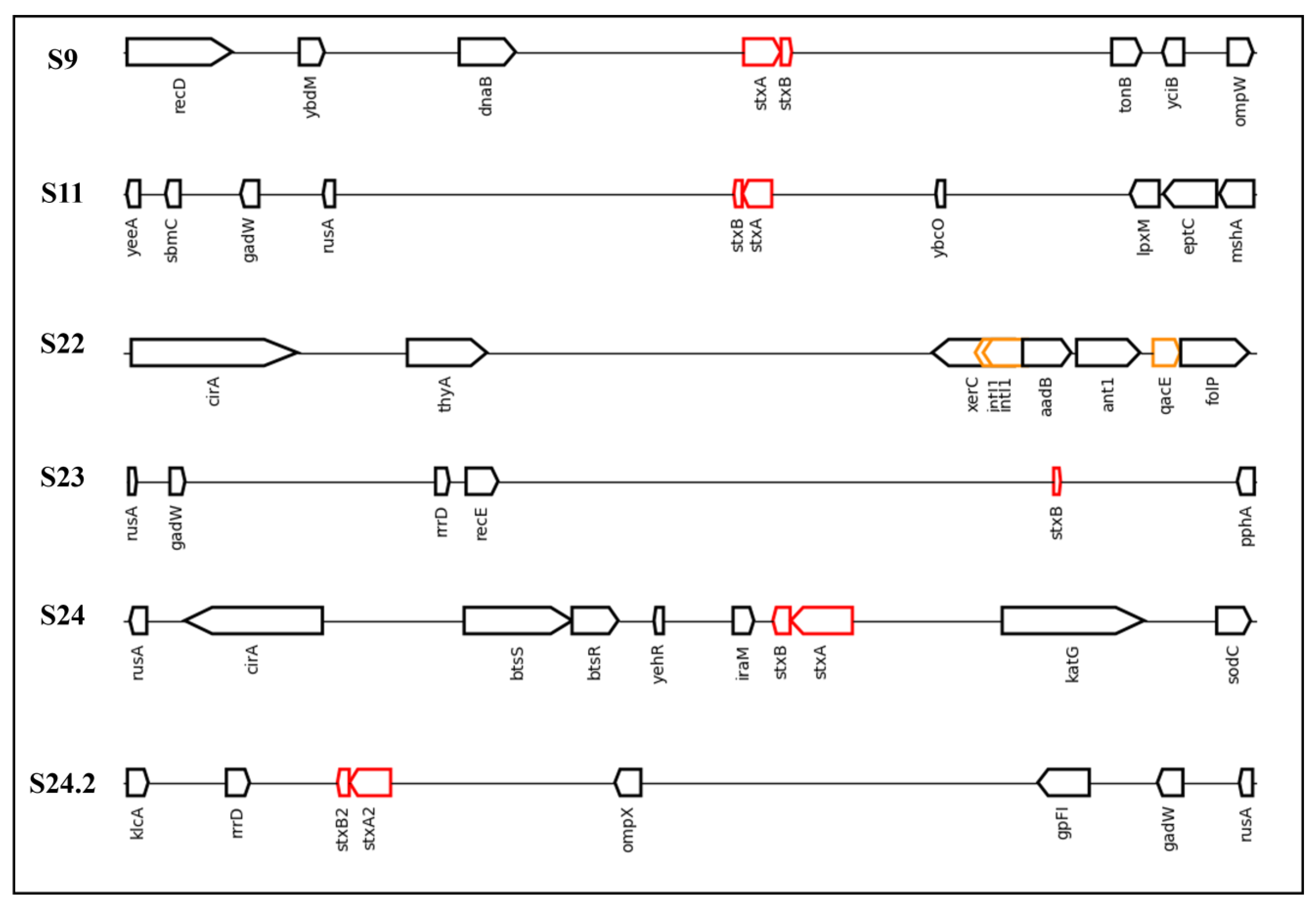
| Strain | Serogroup by PCR * | Serotype by WGS | STEC or Tolerance Gene Presence | Ammonium Quaternary Resistance (ppm) * | Peracetic Acid Resistance (ppm) * |
|---|---|---|---|---|---|
| S1 | O45 | O45:H19 | Negative | 12.5 | 12.5 |
| S2 | O26 | O26 | Negative | 12.5 | 25 |
| S3 | O103 | O103:H2 | Negative | 6.25 | 25 |
| S4 | O157 | O154:H55 ** | Negative | 12.5 | 25 |
| S5 | O45 | O45:H9 | Negative | 12.5 | 12.5 |
| S6 | O45 | O45:H4 | Negative | 6.25 | 25 |
| S7 | O103 | O103:H2 | Negative | 12.5 | 12.5 |
| S8 | O103 | O103:H2 | Negative | 12.5 | 25 |
| S9 | O111 | O111:H8 | stx1-Positive | 6.25 | 12.5 |
| S10 | O121 | O121:H46 | Negative | 6.25 | 12.5 |
| S11 | O111 | O111:H8 | stx1-Positive | 6.25 | 25 |
| S12 | O26 | O26 | Negative | 12.5 | 12.5 |
| S13 | O157 | O157:H29 | Negative | 12.5 | 25 |
| S14 | O26 | O131:H26 ** | Negative | 12.5 | 12.5 |
| S15 | O26 | O26:H11 | Negative | 12.5 | 12.5 |
| S16 | O103 | O103:H21 | Negative | 12.5 | 25 |
| S17 | O45 | O45:H4 | Negative | 12.5 | 12.5 |
| S18 | O121 | O121:H46 | Negative | 12.5 | 6.25 |
| S19 | O45 | O45:H4 | Negative | 12.5 | 12.5 |
| S20 | O121 | O121:H46 | Negative | 12.5 | 25 |
| S21 | O121 | O121:H7 | Negative | 12.5 | 25 |
| S22 | O26 | O17:H18 ** | Negative, qacE-Positive | 12.5 | 25 |
| S23 | O157 | O157:H7 | stx1-Positive | 6.25 | 25 |
| S24 | O157 | O157:H7 | stx1- and stx2-Positive | 12.5 | 12.5 |
| Genes | Sanitizer | Spearman’s Correlation Coefficient |
|---|---|---|
| stx | Quaternary Ammonium | −0.694 |
| cbtA | Peracetic Acid | 0.691 |
| qac and stx1 Genes | |||
|---|---|---|---|
| Variables | stx1 Gene + | stx1 Gene − | Total |
| qac Gene + | 3155 (3.17%) | 96,114 (96.83%) | 99,269 |
| qac Gene − | 67,467 (22.95%) | 226,480 (77.05%) | 293,947 |
| Total | 70,622 (17.96%) | 322,594 (82.04%) | 393,216 |
| Statistical Analysis | |||
| Chi-Square (χ2, df = 1) | 19.67; p < 0.0001 | ||
| Odds Ratio (IC 95%) | 0.11 (0.106–0.114) | ||
| Phi (φ) Coefficient | 0.22 | ||
| qac and stx2 Genes | |||
| Variables | stx2 gene + | stx2 gene − | Total |
| qac Gene + | 4907 (4.94%) | 94,362 (95.06%) | 99,269 |
| qac Gene − | 62,355 (21.21%) | 231,592 (78.79%) | 293,947 |
| Total | 67,262 (17.10%) | 325,954 (82.90%) | 393,216 |
| Statistical Analysis | |||
| Chi-Square (χ2, df = 1) | 13.85; p < 0.0001 | ||
| Odds Ratio (IC 95%) | 0.19 (0.184–0.196) | ||
| Phi (φ) Coefficient | 0.19 | ||
| qac and stx1 and stx2 Genes | |||
| Variables | stx1 and stx2 gene + | stx1 gene and stx2 − | Total |
| qac Gene + | 8062 (8.12%) | 91,207 (91.88%) | 99,269 |
| qac Gene − | 105,401 (35.86%) | 188,546 (64.14%) | 293,947 |
| Total | 113,463 (28.86%) | 279,753 (71.14%) | 393,216 |
| Statistical Analysis | |||
| Chi-Square (χ2, df = 1) | 24.74; p < 0.0001 | ||
| Odds Ratio (IC 95%) | 0.17 (0.166–0.174) | ||
| Phi (φ) Coefficient | 0.25 | ||
Disclaimer/Publisher’s Note: The statements, opinions and data contained in all publications are solely those of the individual author(s) and contributor(s) and not of MDPI and/or the editor(s). MDPI and/or the editor(s) disclaim responsibility for any injury to people or property resulting from any ideas, methods, instructions or products referred to in the content. |
© 2025 by the authors. Licensee MDPI, Basel, Switzerland. This article is an open access article distributed under the terms and conditions of the Creative Commons Attribution (CC BY) license (https://creativecommons.org/licenses/by/4.0/).
Share and Cite
Castro, V.S.; Porto, Y.D.; Yang, X.; Conte Junior, C.A.; Figueiredo, E.E.d.S.; Stanford, K. The Trade-Off Between Sanitizer Resistance and Virulence Genes: Genomic Insights into E. coli Adaptation. Antibiotics 2025, 14, 291. https://doi.org/10.3390/antibiotics14030291
Castro VS, Porto YD, Yang X, Conte Junior CA, Figueiredo EEdS, Stanford K. The Trade-Off Between Sanitizer Resistance and Virulence Genes: Genomic Insights into E. coli Adaptation. Antibiotics. 2025; 14(3):291. https://doi.org/10.3390/antibiotics14030291
Chicago/Turabian StyleCastro, Vinicius Silva, Yuri Duarte Porto, Xianqin Yang, Carlos Adam Conte Junior, Eduardo Eustáquio de Souza Figueiredo, and Kim Stanford. 2025. "The Trade-Off Between Sanitizer Resistance and Virulence Genes: Genomic Insights into E. coli Adaptation" Antibiotics 14, no. 3: 291. https://doi.org/10.3390/antibiotics14030291
APA StyleCastro, V. S., Porto, Y. D., Yang, X., Conte Junior, C. A., Figueiredo, E. E. d. S., & Stanford, K. (2025). The Trade-Off Between Sanitizer Resistance and Virulence Genes: Genomic Insights into E. coli Adaptation. Antibiotics, 14(3), 291. https://doi.org/10.3390/antibiotics14030291











